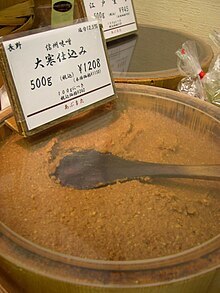Miso

Miso for sale in a Tokyo food hall
|
|
| Alternative names | Soybean paste |
|---|---|
| Place of origin | Japanese |
| Main ingredients | fermented Soybean, with salt and koji (Aspergillus oryzae) |
| |
|
| Nutritional value per 100 g (3.5 oz) | |
|---|---|
| Energy | 831 kJ (199 kcal) |
|
26.47
|
|
| Sugars | 6.2 |
| Dietary fiber | 5.4 |
|
6.01
|
|
| Saturated | 1.139 |
| Monounsaturated | 1.242 |
| Polyunsaturated | 3.204 |
|
11.69
|
|
| Tryptophan | 0.155 g |
| Threonine | 0.479 g |
| Isoleucine | 0.508 g |
| Leucine | 0.82 g |
| Lysine | 0.478 g |
| Methionine | 0.129 g |
| Cystine | 0 g |
| Phenylalanine | 0.486 g |
| Tyrosine | 0.352 g |
| Valine | 0.547 g |
| Arginine | 0.784 g |
| Histidine | 0.243 g |
| Alanine | 0.5 g |
| Aspartic acid | 1.171 g |
| Glutamic acid | 1.915 g |
| Glycine | 0.447 g |
| Proline | 0.619 g |
| Serine | 0.601 g |
| Vitamins | |
| Vitamin A equiv. |
(1%)
4 μg
(0%)
52 μg0 μg
|
| Thiamine (B1) |
(9%)
0.098 mg |
| Riboflavin (B2) |
(19%)
0.233 mg |
| Niacin (B3) |
(6%)
0.906 mg |
| Pantothenic acid (B5) |
(7%)
0.337 mg |
| Vitamin B6 |
(15%)
0.199 mg |
| Folate (B9) |
(5%)
19 μg |
| Vitamin B12 |
(3%)
0.08 μg |
| Choline |
(15%)
72.2 mg |
| Vitamin C |
(0%)
0 mg |
| Vitamin D |
(0%)
0 IU |
| Vitamin E |
(0%)
0.01 mg |
| Vitamin K |
(28%)
29.3 μg |
| Minerals | |
| Calcium |
(6%)
57 mg |
| Iron |
(19%)
2.49 mg |
| Magnesium |
(14%)
48 mg |
| Manganese |
(41%)
0.859 mg |
| Phosphorus |
(23%)
159 mg |
| Potassium |
(4%)
210 mg |
| Sodium |
(249%)
3728 mg |
| Zinc |
(27%)
2.56 mg |
| Other constituents | |
| Water | 50 |
| Alcohol (ethanol) | 0 |
|
|
| Percentages are roughly approximated using US recommendations for adults. Source: USDA Nutrient Database |
|
Miso (みそ or 味噌?) is a traditional Japanese seasoning produced by fermenting soybeans with salt and koji (the fungus Aspergillus oryzae) and sometimes rice, barley, or other ingredients. The result is a thick paste used for sauces and spreads, pickling vegetables or meats, and mixing with dashi soup stock to serve as miso soup called misoshiru (味噌汁), a Japanese culinary staple. High in protein and rich in vitamins and minerals, miso played an important nutritional role in feudal Japan. Miso is still widely used in Japan, both in traditional and modern cooking, and has been gaining worldwide interest.
Typically, miso is salty, but its flavor and aroma depend on various factors in the ingredients and fermentation process. Different varieties of miso have been described as salty, sweet, earthy, fruity, and savory. The traditional Chinese analogue of miso is known as dòujiàng.
The origin of the miso of Japan is not completely clear.
In the Kamakura era (1192–1333), a common meal was made up of a bowl of rice, some dried fish, a serving of miso, and a fresh vegetable. Until the Muromachi era (1337 to 1573), miso was made without grinding the soybeans, somewhat like nattō. In the Muromachi era, Buddhist monks discovered that soybeans could be ground into a paste, spawning new cooking methods using miso to flavor other foods. In medieval times, the word temaemiso, meaning home-made miso, appeared. Miso production is a relatively simple process, so home-made versions spread throughout Japan. Miso was used as military provisions during the Sengoku era and making miso was an important economic activity for daimyōs of that era.
...
Wikipedia
